Medical transcription continues to be a critical function in clinical documentation, where precision, speed, and compliance are non-negotiable. In 2025, speech-to-text software plays an increasingly central role in reducing administrative burden for healthcare professionals while improving accuracy and accessibility of patient records. From handling complex medical terminology to supporting multilingual inputs and integrating with electronic health records, the right tool can significantly improve workflow efficiency in clinical environments.
This article identifies eight speech-to-text platforms that stand out in 2025 for medical transcription use cases. It highlights how each tool approaches transcription, their accuracy levels, and feature sets tailored for healthcare needs, including security compliance, timestamping, speaker labeling, and specialized medical formatting.
Whether you are a solo practitioner or part of a large hospital network, this guide is designed to help you select a transcription solution that fits your operational and clinical requirements.
Key Takeaways
- Medical speech-to-text software can save healthcare professionals up to 2-3 hours daily on documentation, with the best solutions offering 95%+ accuracy for medical terminology
- Top solutions like Sonix offer multi-language support and specialized medical vocabulary recognition, making them suitable for international healthcare settings
- When selecting software, consider accuracy with medical terminology, EHR integration capabilities, and privacy compliance relevant to your region
- Most solutions offer flexible pricing models ranging from $10-30 per hour of dictation or $29-79 monthly subscriptions
- Deployment options range from cloud-based to on-premises solutions, with varying levels of IT requirements and security features
8 Best Speech-to-Text Software for Medical Transcription
- Sonix
- Dragon Medical One
- Descript
- Rev
- Philips SpeechLive
- Amazon Transcribe Medical
- GoTranscript
- Suki AI
1. Sonix
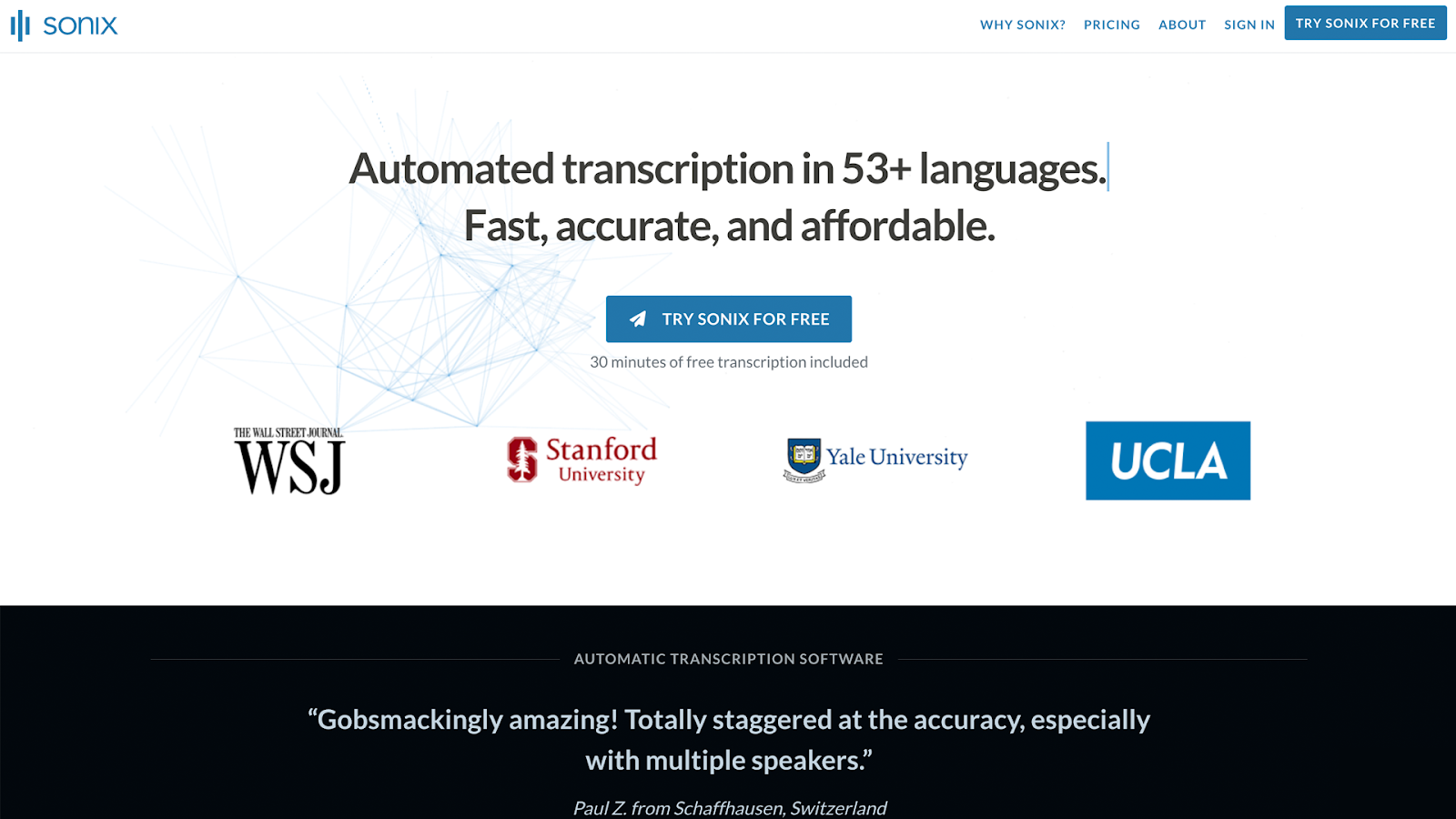
Sonix stands out as a versatile and accurate speech-to-text solution that has become increasingly popular among healthcare professionals seeking efficient documentation tools without being locked into healthcare-specific ecosystems.
Unlike traditional medical dictation software that requires extensive training, Sonix uses advanced AI technology to quickly adapt to individual speaking patterns, accents, and specialized terminology, making it accessible even for professionals with limited technical experience.
Key Features
Here are some of Sonix’s key features that make it the premier speech-to-text software for medical transcription in 2025.
Security and Confidentiality
Sonix prioritizes data protection through enterprise-grade security measures. All data is encrypted both at rest and in transit using bank-level SSL certificates and encryption algorithms.
The platform’s SOC 2 Type 2 compliance, verified via Drata’s automation platform, ensures continuous monitoring of over 100 internal security controls. This rigorous approach to security makes Sonix suitable for businesses handling sensitive information, providing assurance that proprietary data and client communications remain confidential and protected against unauthorized access.
Accuracy and Reliability
Sonix delivers highly accurate automated transcriptions, minimizing the need for manual corrections. Our advanced AI algorithms are trained to handle a variety of audio formats and languages with up to 99% accuracy, ensuring reliable transcription across diverse business contexts.
This level of precision is particularly beneficial for organizations requiring dependable documentation of meetings, interviews, or legal proceedings, where accuracy is paramount.
AI Analysis Tools
Beyond transcription, Sonix offers AI-powered analysis tools that transform raw transcripts into actionable insights. Features include automated summarization, topic detection, and the generation of chapter titles, enabling businesses to extract key information from lengthy recordings quickly.
These tools facilitate efficient content review and decision-making processes, especially in environments where time-sensitive analysis is critical.
Collaboration Capabilities
Sonix enhances team collaboration by allowing multiple users to work on transcripts simultaneously. The platform supports role-based permissions, enabling administrators to control access levels and maintain document integrity.
This collaborative environment streamlines workflows, making it easier for teams to edit, review, and finalize transcriptions collectively, which is particularly advantageous for projects involving cross-functional teams or multiple stakeholders.
Third-Party Integrations
Sonix seamlessly integrates with a variety of third-party applications, including productivity tools like Zapier, Dropbox, Google Drive, and CRM systems such as Salesforce.
These integrations allow businesses to effortlessly incorporate Sonix into existing workflows, automating tasks like file uploads and data synchronization. By connecting with tools already in use, Sonix enhances operational efficiency and reduces the need for manual data handling.
Pricing
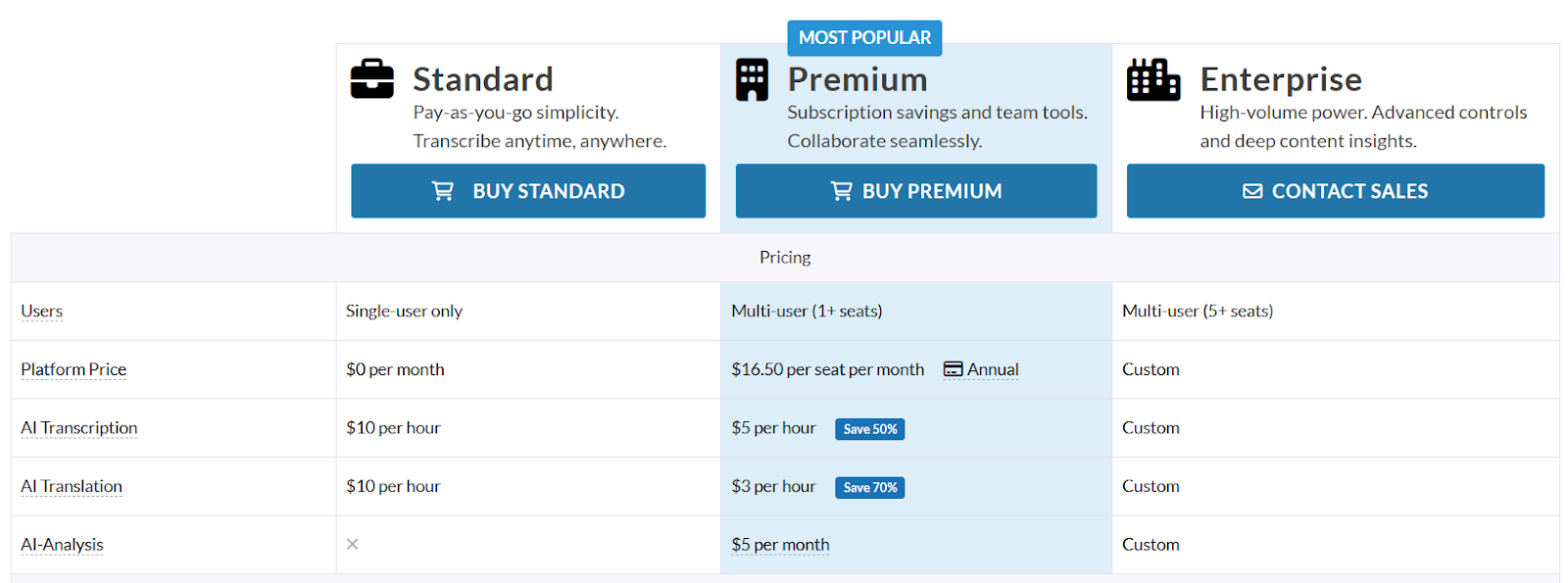
Sonix offers straightforward pricing options:
- Pay-as-you-go: $10 per hour of audio
- Premium subscription: $5 per hour plus $22 monthly fee per user
- Enterprise: Custom pricing for larger organizations
Start transcribing medical dictations with Sonix today! Sign up for a 30-minute free trial — no credit card required.
2. Dragon Medical One

Dragon Medical One is a cloud-based speech recognition solution by Nuance, designed for clinical environments. It enables real-time dictation directly into EHRs, with high accuracy for medical terminology. Its lightweight desktop app supports mobility and integrates with tools like PowerMic.
HIPAA-compliant and optimized for fast documentation, Dragon Medical One is widely used in hospitals and private practices to reduce clinician burnout and improve workflow efficiency.
Key Features
- Extensive Medical Vocabulary Across Specialties: Dragon Medical One includes comprehensive voice recognition models trained on medical terminology from over 90 specialties and subspecialties. This enables highly accurate, context-aware transcription for clinicians across diverse fields such as radiology, psychiatry, cardiology, and pediatrics.
- Embedded EHR Integration for Real-Time Input: The software integrates natively with leading EHR platforms like Epic, Cerner, Meditech, and Allscripts. Clinicians can dictate directly into patient charts, populate structured fields, and navigate through EHR interfaces without toggling between windows or retyping notes.
- Cloud-Connected Mobile Access: Dragon Medical One is a cloud-based solution that supports mobile dictation via companion apps. Physicians can dictate and review notes securely from smartphones or tablets, enabling flexible documentation during rounds, remote consults, or between patient visits.
- Voice-Driven EHR Navigation and Shortcuts: Beyond dictation, the platform includes customizable voice commands that allow clinicians to search patient records, open lab results, insert templates, and control other EHR functions—significantly reducing keyboard use and improving documentation speed and consistency.
Pricing
Dragon Medical One only features custom pricing for its transcription services.
3. Descript
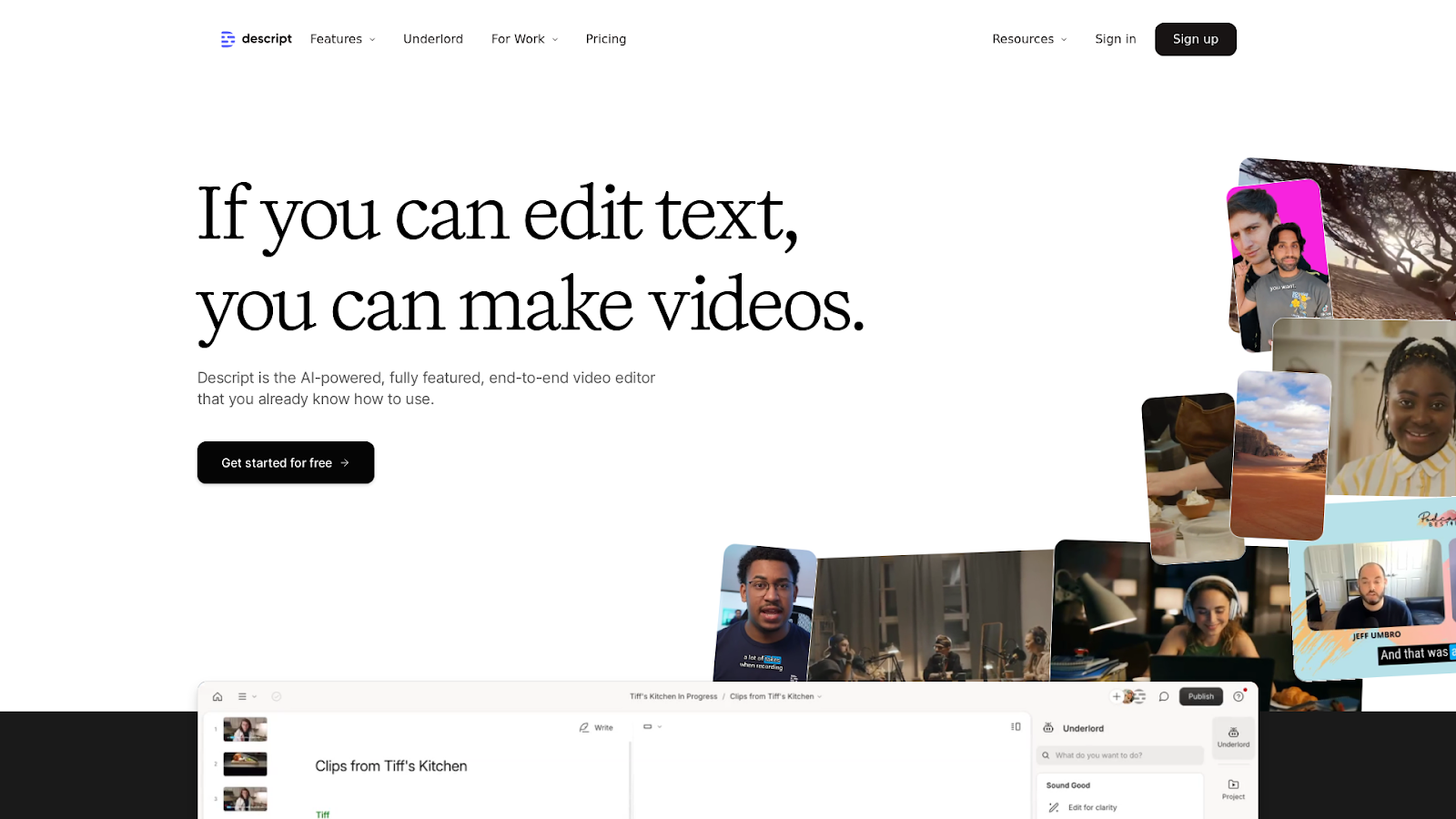
Descript is an audio and video editing platform that includes automatic transcription as part of its core feature set. While not specifically tailored to medical transcription, it allows users to edit recordings by modifying the transcript text directly.
It includes speaker labeling, multitrack editing, and collaboration tools. Transcription accuracy is moderate and best suited for clear, structured speech. Its primary strength lies in combining transcription with content production workflows, making it more useful for telehealth recordings than clinical documentation.
Key Features
- Transcript-Based Media Editing: Users can edit audio and video files by editing the text transcript itself, cutting, rearranging, and polishing content as if working in a word processor. Ideal for telehealth documentation or training materials.
- Multitrack Recording and Editing: Supports separate audio/video tracks for each participant in a conversation, allowing clearer analysis of multi-speaker recordings such as roundtables or multidisciplinary medical discussions.
- Built-In Screen Recorder and Overdub: Includes a screen recording feature and AI-powered voice synthesis (Overdub) to generate audio corrections, useful for creating narrated walkthroughs, explainer videos, or amending dictation without re-recording.
- Collaboration and Version Control: Offers shared project workspaces, real-time editing, and automatic version history, enabling medical teams to collaboratively review, annotate, and finalize documentation or educational content.
Pricing
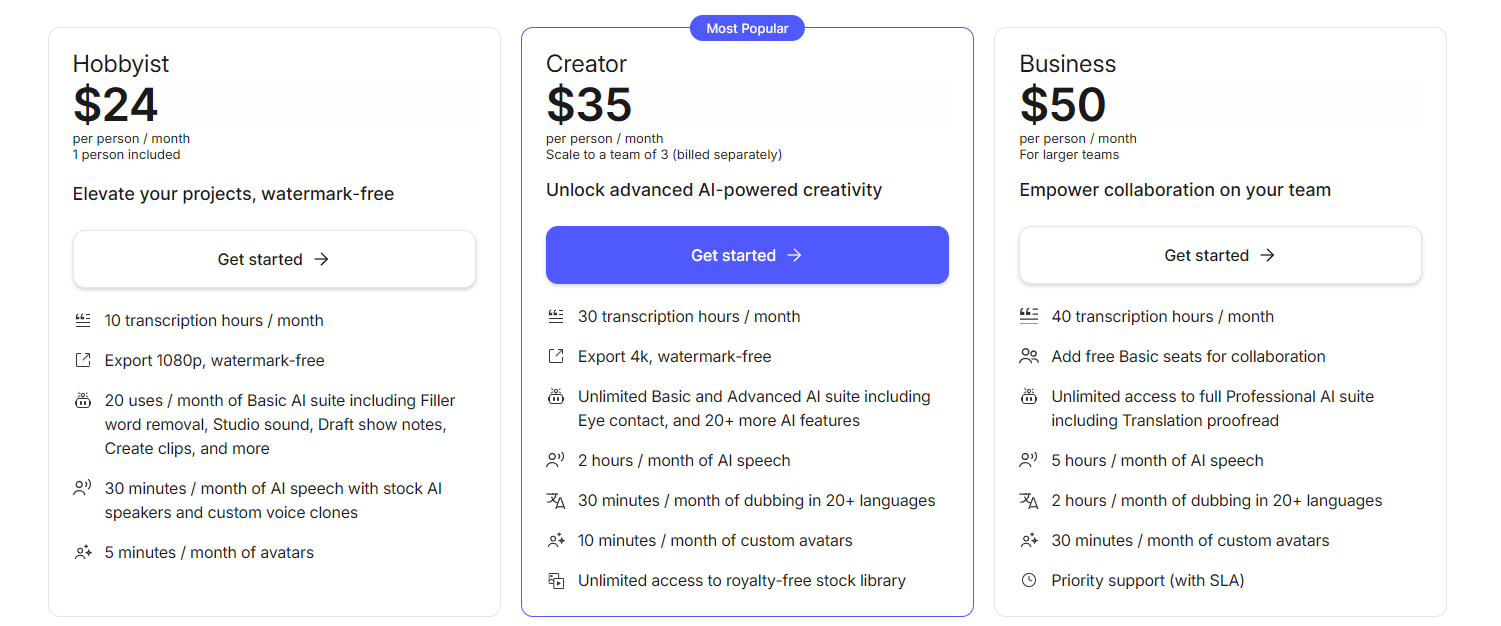
- Free Plan: Includes limited transcription and editing features suitable for trial or casual usage.
- Paid Plans: Hobbyist ($24/mo), Creator ($35/mo), Business ($50/mo), each tier offering higher transcription minutes and access to advanced tools.
4. Rev
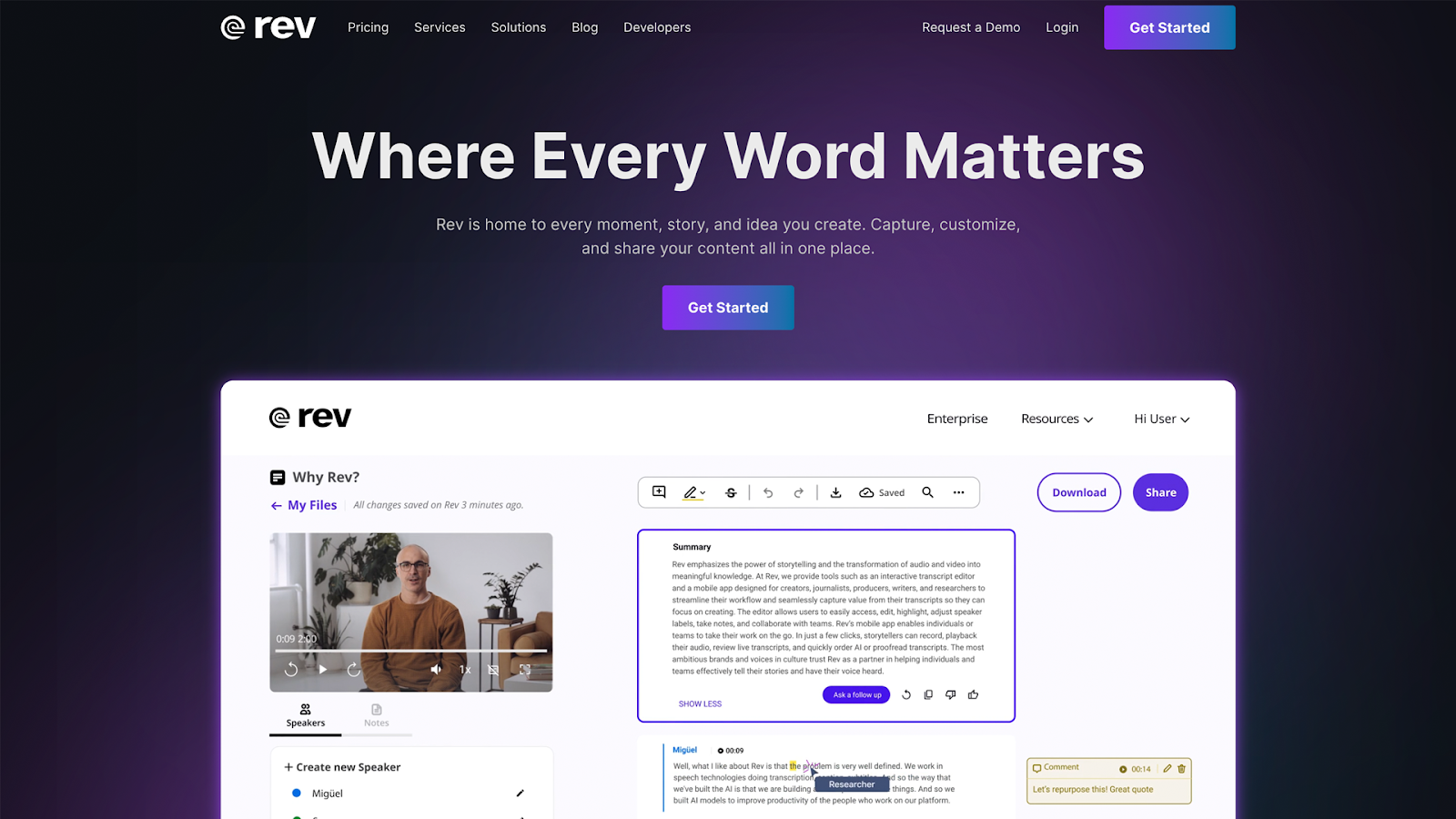
Rev offers both human and AI-driven transcription services, including support for medical and clinical content. With a turnaround time of minutes for AI and hours for human-reviewed transcripts, Rev is useful for medical professionals needing detailed, timestamped documentation.
It supports file uploads and integrates with video platforms, though it lacks deeper medical EHR integration.
Key Features
- Integrated AI Notetaker for Virtual Meetings: Rev’s AI Notetaker can join meetings on Zoom, Google Meet, or Microsoft Teams, recording and transcribing the session in real time with speaker identification and live note generation.
- Interactive Transcript Editor: Users can review, search, and edit transcripts in-browser using a clean, collaborative editor that supports highlighting, commenting, and real-time changes across teams.
- Mobile Access and On-the-Go Recording: The Rev Mobile App enables users to record, transcribe, and edit audio on mobile devices, making it useful for clinicians and researchers working across multiple locations.
- Language Support and AI Summary Tools: Higher-tier plans support AI-generated captions in 37+ languages and include access to customizable AI summary templates for generating structured meeting notes and insights.
Pricing
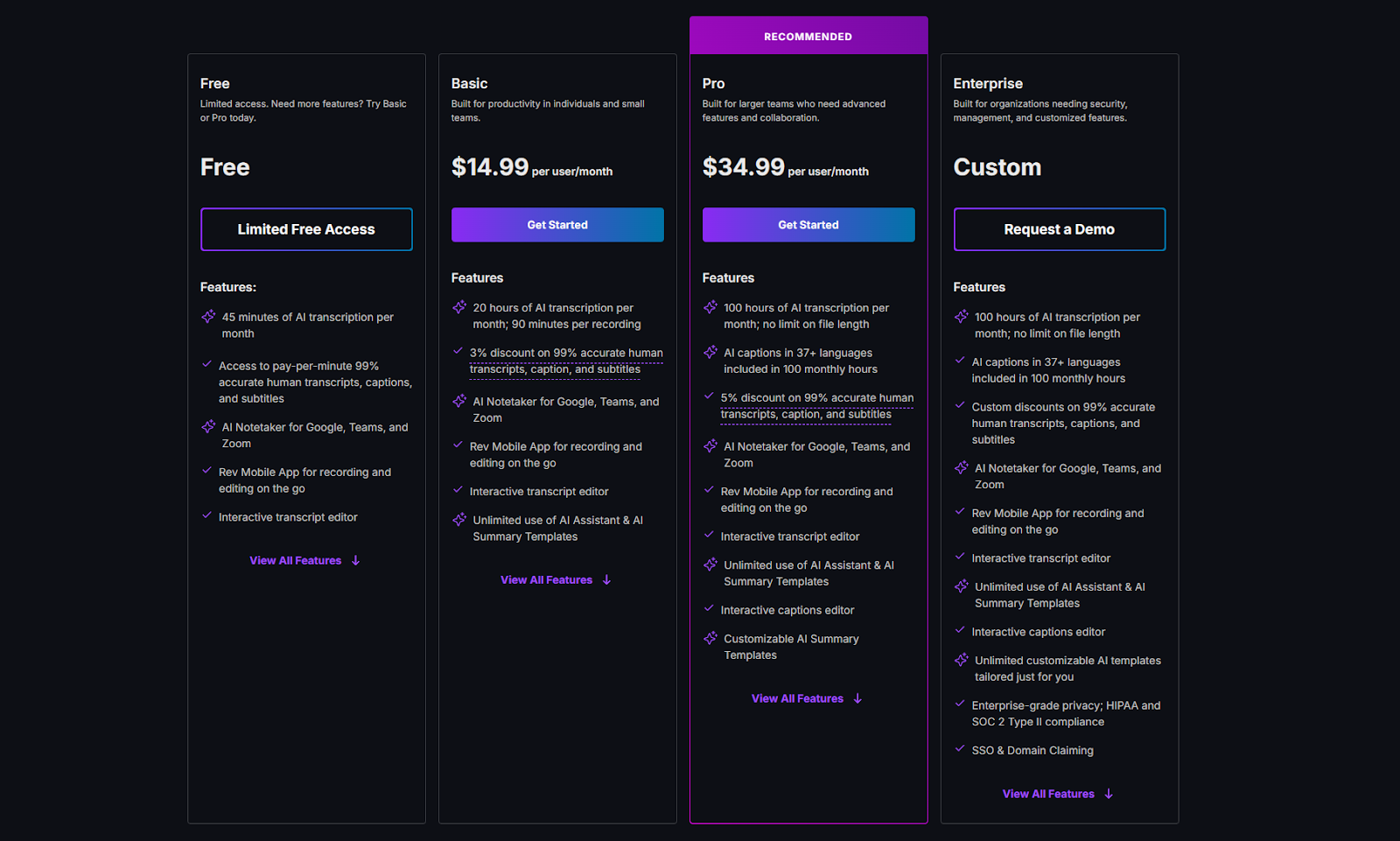
- Free Plan: Includes 45 minutes of AI transcription per month, access to the AI Notetaker, and interactive transcript editing.
- Basic Plan ($14.99/user/month): Offers 20 hours/month of AI transcription (max 90 minutes/recording), a 3% discount on human transcription, and full app/editor access.
- Pro Plan ($34.99/user/month): Includes 100 hours/month of AI transcription, 5% discount on human services, multilingual captions, and advanced AI templates.
- Enterprise (Custom Pricing): Offers custom AI templates, HIPAA/SOC 2 Type II compliance, SSO, and domain-level controls, with tailored discounts for large-scale transcription and captioning.
5. Philips SpeechLive

Philips SpeechLive is a cloud-based dictation and transcription solution that bridges the gap between traditional dictation workflows and modern speech recognition technology. It’s designed to be flexible for various professional settings, including healthcare.
Philips SpeechLive offers flexibility between automated and human transcription, making it adaptable to different documentation needs and accuracy requirements. However, it lacks some of the healthcare-specific features found in dedicated medical dictation systems.
Key Features
- Multiple Input Options Across Devices: Philips SpeechLive supports dictation via Philips hardware (like SpeechMike and PocketMemo), mobile apps, and browser-based tools. This flexibility enables clinicians to record and submit dictations from clinic workstations, home offices, or while on the move.
- Hybrid Transcription: Human and Automated Services: Users can choose between automated AI transcription for quick results or professional human transcription for higher accuracy. This dual option allows healthcare teams to balance speed and quality depending on the sensitivity or complexity of the medical content.
- Centralized Workflow Management Tools: SpeechLive includes web-based workflow features such as role assignment, status tracking, and folder-based organization for large transcription volumes. Administrators can manage multiple authors and transcriptionists, ensuring efficient routing, tracking, and auditing of medical dictation tasks.
- Urgency-Based Priority Routing: The platform allows users to mark specific dictations as high priority, automatically placing them at the front of the transcription queue. This ensures time-sensitive cases, such as discharge summaries or surgical notes, receive faster turnaround without manual follow-up.
Pricing
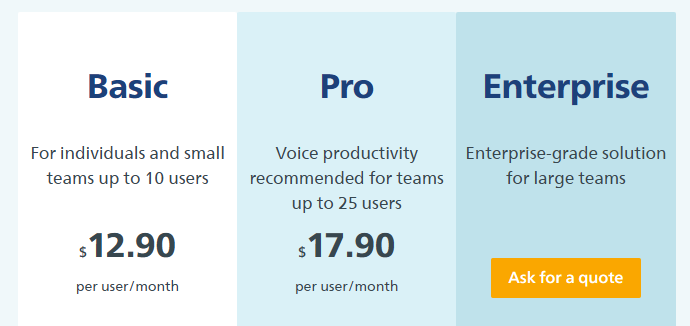
- Basic Plan: Starts at approximately $12.9 per month. Suitable for smaller teams up to 10 users.
- Pro Plans: $17.9 per month for bigger teams up to 25 users.
6. Amazon Transcribe Medical
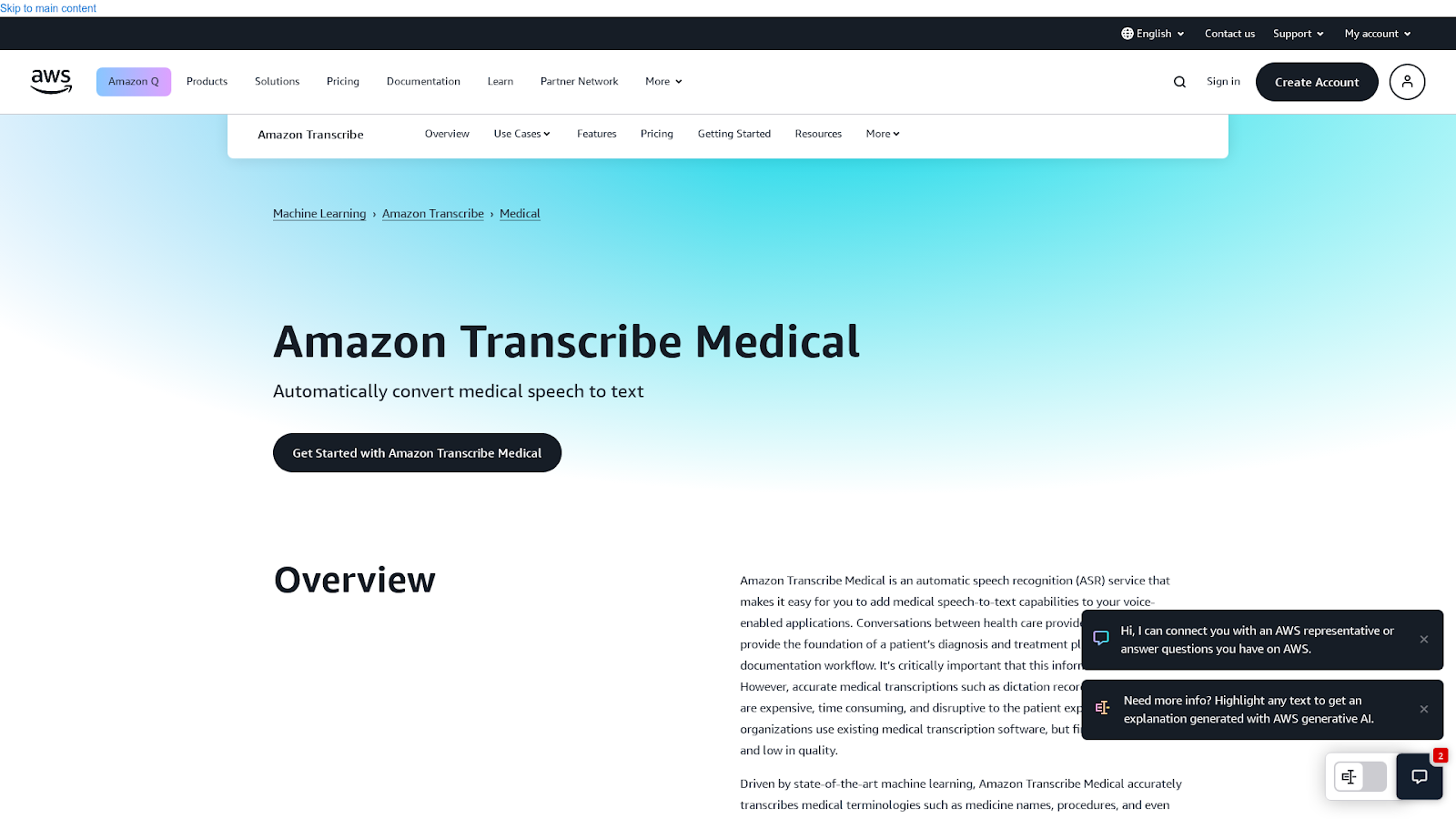
Amazon Transcribe Medical is a real-time, HIPAA-eligible speech recognition service that converts physician-patient conversations into text. It is built to integrate with healthcare applications and supports medical vocabulary across various specialties.
With streaming and batch transcription capabilities, it suits clinical documentation systems aiming to automate data entry. It does not include a native editor but is designed for seamless API integration into third-party platforms such as EHRs and clinical voice applications.
Key Features
- API-Based Integration for Custom Workflows: Amazon Transcribe Medical is delivered entirely through a cloud-based API, allowing healthcare providers and software developers to integrate medical transcription capabilities directly into EHR platforms, virtual care apps, or internal documentation systems without relying on standalone tools.
- Support for Medical Specialties: Built with domain-specific language models, the service recognizes medical terminology across specialties such as cardiology, neurology, primary care, and oncology. This ensures accurate transcription of clinical conversations, improving data reliability and reducing the need for manual corrections.
- HIPAA Eligibility and Data Security: As a HIPAA-eligible service, Amazon Transcribe Medical supports the handling of protected health information (PHI). It is backed by AWS security protocols, including data encryption and access controls, to help healthcare organizations meet regulatory compliance standards.
- Real-Time and Batch Transcription Options: The service supports both streaming (real-time) and batch transcription modes. Clinicians can transcribe live consultations instantly or process pre-recorded audio files, making it suitable for a variety of medical documentation scenarios, from patient visits to telehealth recordings.
Pricing
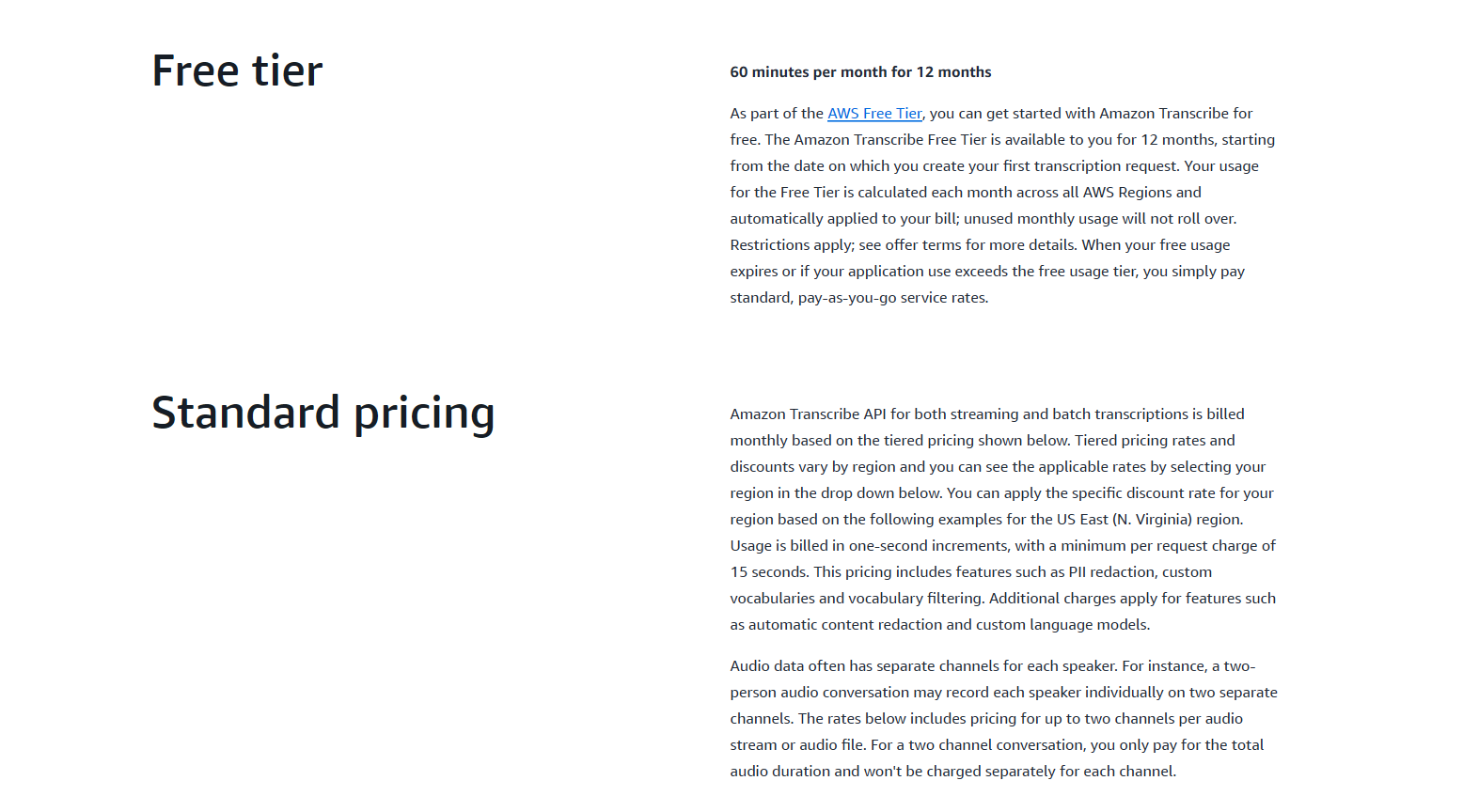
- Free Tier: New AWS users receive 60 minutes per month of transcription free for the first 12 months. This applies across all AWS regions and resets monthly. Unused minutes do not roll over.
- Standard Pricing: Billed monthly based on usage, with rates varying by AWS region. Charges are calculated in one-second increments (minimum 15 seconds per request). This includes access to medical vocabulary models, speaker channel separation, and vocabulary filtering.
- Custom Features: Additional fees apply for advanced options like custom language models and automatic redaction of protected health information (PHI), making it suitable for compliance-driven medical transcription workflows.
7. GoTranscript

GoTranscript is a transcription service that focuses on 100% human-generated transcripts with high accuracy, making it well-suited for medical, academic, and legal industries. With support for over 40 languages, speaker labeling, and timestamping, it caters to organizations that require detailed, multilingual documentation.
In addition to transcription, the platform also offers translation, subtitles, and captioning services. Its emphasis on manual processing, privacy compliance, and optional rapid turnaround makes it a reliable choice for sensitive or complex content.
Key Features
- 100% Human-Generated Transcription: GoTranscript specializes in fully human-produced transcripts, achieving up to 99.4% accuracy. This is particularly valuable for complex or sensitive recordings in medical, academic, and legal contexts where precision is essential.
- Multi-Language and Industry Support: Offers transcription in over 40 languages and supports medical-specific formatting, including speaker labeling, timestamps, and terminology familiar to healthcare professionals. Ideal for international teams and diverse clinical documentation needs.
- Optional Captions, Subtitles, and Translation: In addition to transcription, GoTranscript provides subtitle generation and multilingual translation services, enabling clinics or research teams to localize documentation for global audiences or accessibility requirements.
- Secure and Confidential Handling: All services are GDPR-compliant and manually processed to reduce the risk of errors or privacy breaches. Files are encrypted and handled under strict data protection protocols appropriate for clinical and institutional use.
Pricing
- Human Transcription: Starts at $1.02/minute for a standard 5-day turnaround. Faster delivery options (including 1-day and 6–12-hour turnaround) are available at higher rates.
- AI Transcription: Available at $0.20/minute ($12/hour), though with lower accuracy compared to human transcription.
- Add-On Services: Translation, subtitles, and verbatim formatting are available at additional cost depending on language pair and content type.
8. Suki AI

Suki AI is an AI-powered digital assistant designed specifically for healthcare documentation. Through voice commands and contextual awareness, it aims to reduce doctors’ administrative burden.
Suki AI offers a sophisticated AI assistant approach rather than simple dictation, but requires integration with supported EHR systems and may have limited availability outside North America.
Key Features
- Ambient Listening for Clinical Documentation: Suki uses ambient technology to listen passively during patient consultations and automatically generate detailed clinical notes. This reduces the need for manual typing or after-hours documentation, allowing physicians to focus more on patient care than administrative tasks.
- Seamless EHR Integration: Suki integrates directly with leading Electronic Health Record systems such as Epic, Cerner, and Athenahealth. It enables real-time insertion of dictated notes, retrieval of patient data, and documentation updates, streamlining workflows without requiring clinicians to navigate multiple systems.
- Specialty-Specific Language Models: Suki’s AI engine is trained to recognize and accurately process terminology used across various medical specialties, including cardiology, orthopedics, internal medicine, and more. This ensures higher accuracy in transcription and relevance in generated summaries and assessments.
- Voice-Activated Commands for Efficiency: Clinicians can interact with Suki using natural language voice commands to create notes, retrieve charts, update medications, or insert templates. This hands-free functionality supports faster documentation and reduces the cognitive load associated with menu-driven EHR interfaces.
Pricing
Suki only supports custom pricing at this time.
How to Choose the Best Speech-to-Text Software for Medical Transcription
Selecting the right speech-to-text software for your medical practice involves evaluating several key factors. Here are some of those factors you should keep an eye on.
Accuracy with Medical Terminology
The most important consideration is how well the software recognizes specialized medical terminology. Look for solutions with medical vocabularies relevant to your specialty.
Many healthcare professionals find that general-purpose transcription solutions with custom vocabulary capabilities (like Sonix) can match or exceed specialty-specific solutions after a brief training period.
Integration Capabilities
Consider how the software will fit into your existing workflow. Some solutions integrate directly with EHR systems, while others provide output that can be copied into your documentation system.
Evaluate whether direct integration is necessary for your workflow or if a more flexible system would better serve international or specialized practices.
Privacy and Compliance
Different regions have different healthcare privacy requirements. Ensure the solution you choose complies with relevant regulations in your practice location, whether that’s HIPAA in the US, GDPR in Europe, or other regional standards.
Look for features like encryption, access controls, and compliance certifications.
Language Support
For practices serving diverse populations or operating in multilingual environments, robust language support is essential. Solutions like Sonix offer extensive language capabilities, making them suitable for international settings.
Cost Structure
Consider not just the upfront cost but the total cost of ownership, including:
- Monthly subscription fees
- Per-minute or per-hour charges
- Hardware requirements
- Training costs
- Support and maintenance fees
Best Speech-to-Text Software for Medical Transcription at a Glance
| Software | Accuracy for Medical Terms | Languages | Pricing |
| Sonix | Up to 99% with custom vocabulary | 53+ | $10/hour or $5/hour with subscription |
| Dragon Medical One | 95% | Only English | Custom Pricing |
| Descript | 90-95% | 25+ | Starting at $24/month |
| Rev | 90-95% | 30+ | Starting at $14.99 per month |
| Philips SpeechLive | 90-95% | 20+ | Starting at $12.90 |
| Amazon Transcribe Medical | 90-95% | Only English | Usage-based pricing |
| GoTranscript | 85% for AI Transcription | 50+ | Starting at $12 per hour for AI and $1.04 per minute for human transcription |
| Suki AI | 90-95% | 50+ | Custom pricing |
Final Thoughts
After thoroughly evaluating the leading speech-to-text solutions for medical transcription, Sonix emerges as the most versatile option for diverse healthcare settings worldwide.
What sets Sonix apart is its combination of exceptional accuracy, extensive language support, robust security features, and flexible implementation options. While purpose-built medical solutions like Dragon Medical One and Amazon Medical offer deep EHR integration, they often come with higher costs and more limited language capabilities.
Sonix provides comprehensive tools for healthcare professionals who need to document efficiently across language barriers. Its AI technology understands complex medical terminology and continuously improves with use, adapting to individual speaking patterns and specialty-specific vocabulary.
For healthcare professionals seeking to reduce documentation time while maintaining accuracy, Sonix offers the ideal balance of performance, accessibility, and value.
Want to know what makes us different? Try Sonix free for 30 minutes and see how it can transform your medical documentation workflow.
Best Speech-to-Text Software for Medical Transcription: Frequently Asked Questions
How Accurate Is Speech-To-Text Software for Medical Terminology?
The best speech-to-text software for medical transcription achieves 95-99% accuracy for medical terminology. Solutions like Sonix and Dragon Medical One offer the highest accuracy rates, especially after customization with specialty-specific terms. Accuracy improves over time as the AI adapts to individual speaking patterns and specialized vocabulary.
Can Speech-To-Text Software Integrate With My Existing EHR System?
Many speech-to-text solutions offer integration with popular EHR systems. Dragon Medical One and Amazon Transcribe Medical provide direct integration with major EHR platforms like Epic and Cerner. More versatile solutions like Sonix offer APIs that allow custom integration developed by your IT team. Always verify compatibility with your specific EHR system before making a purchase.
What Languages Are Supported by Medical Transcription Software?
Language support varies significantly among medical transcription software. Sonix leads with support for 53+ languages, making it ideal for international practices. Dragon Medical One supports English with medical vocabulary. Most healthcare-specific solutions prioritize English with limited support for other languages, which can be a significant limitation for practices serving diverse populations.
How Much Time Can Speech-To-Text Software Save on Medical Documentation?
Healthcare professionals using speech-to-text software report saving 2-3 hours daily on documentation tasks. Dictation is approximately three times faster than typing, with the average physician able to dictate at 150 words per minute compared to typing at 40-50 words per minute. This efficiency translates to seeing more patients or improving work-life balance.
World's Most Accurate AI Transcription
Sonix transcribes your audio and video in minutes — with accuracy that'll make you forget it's automated.






